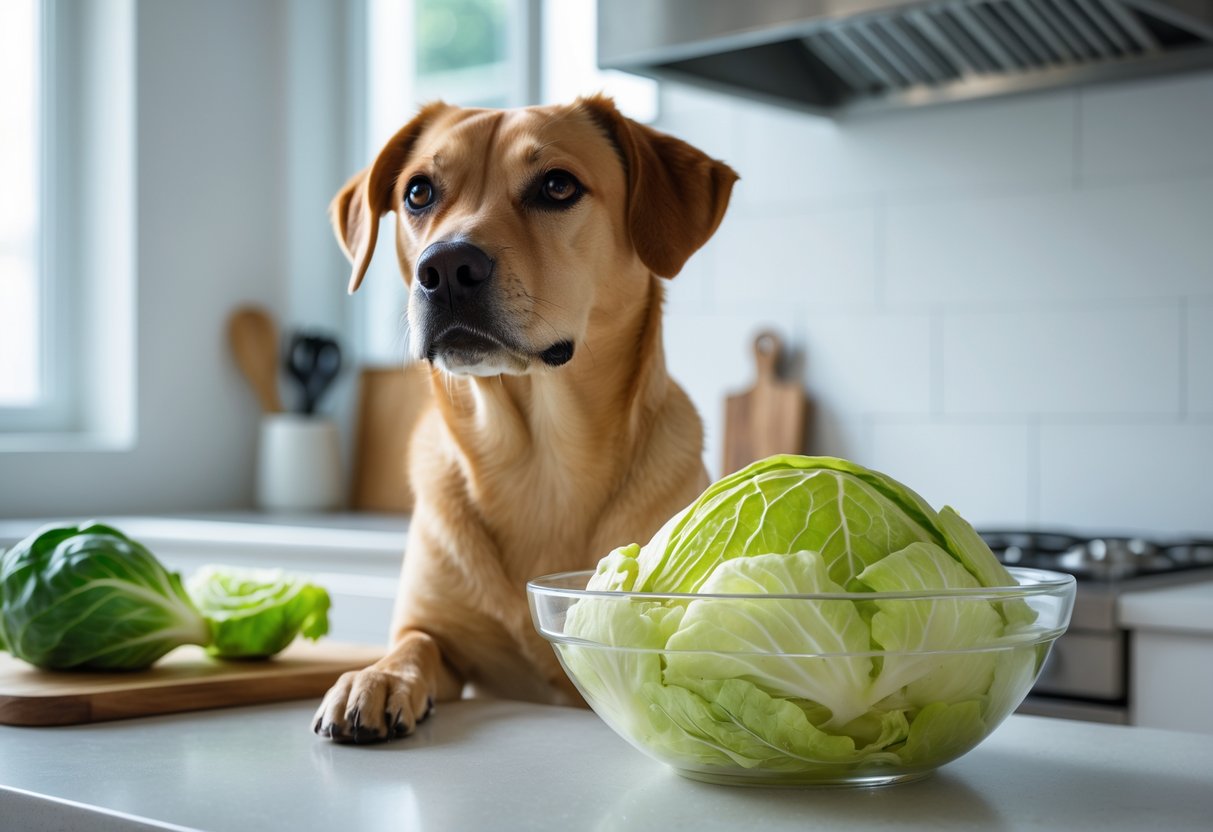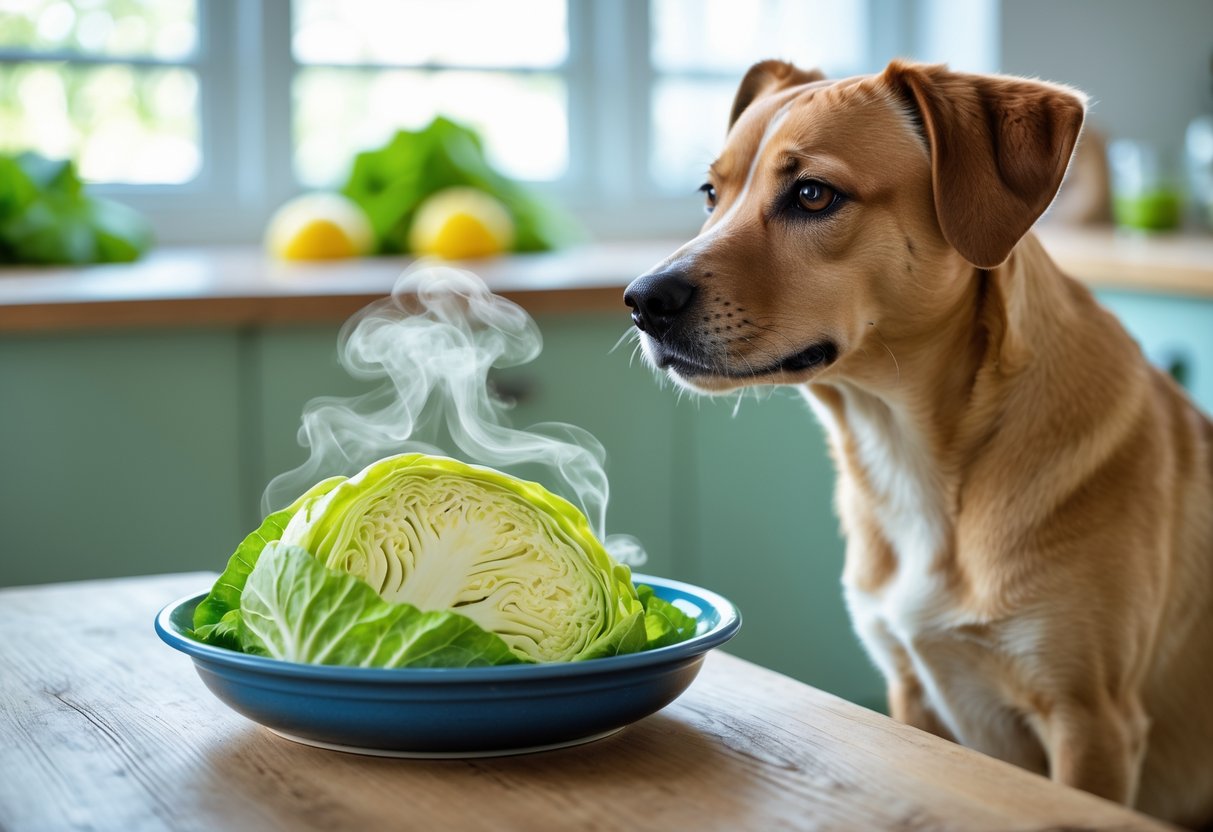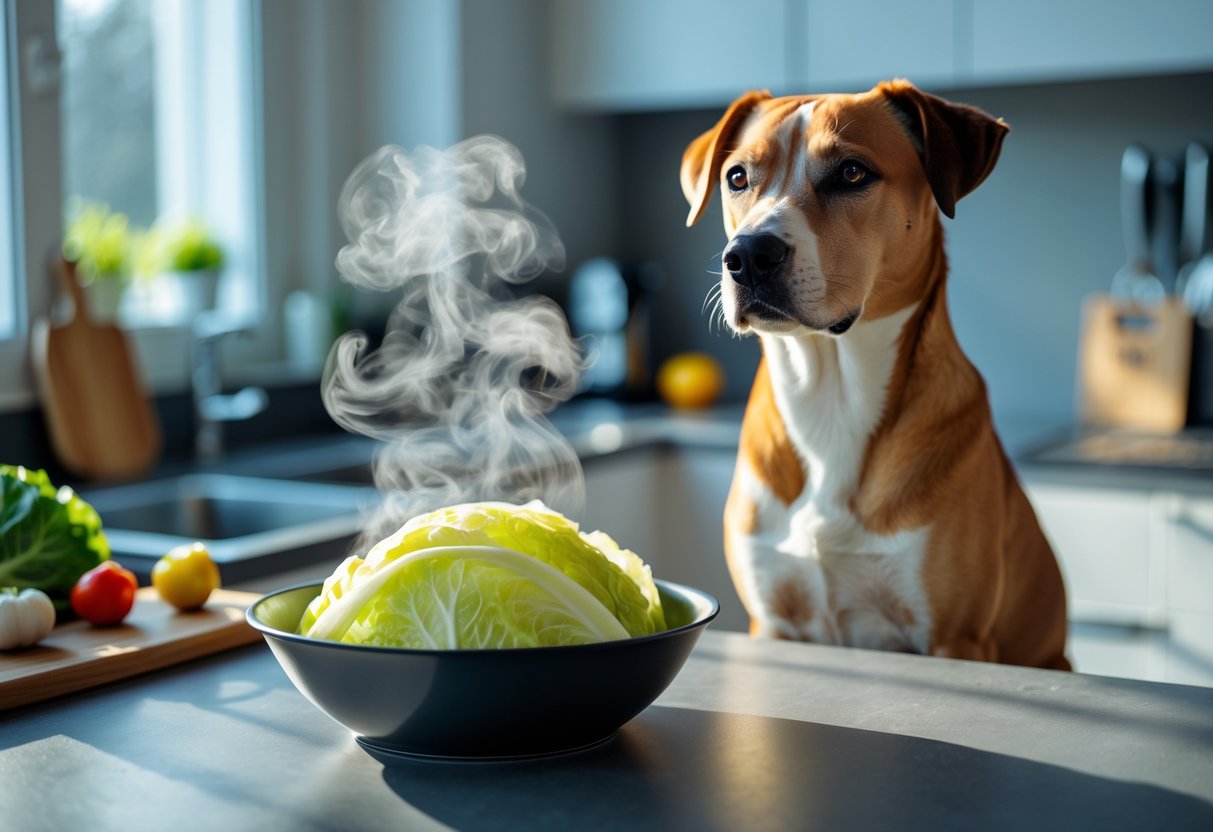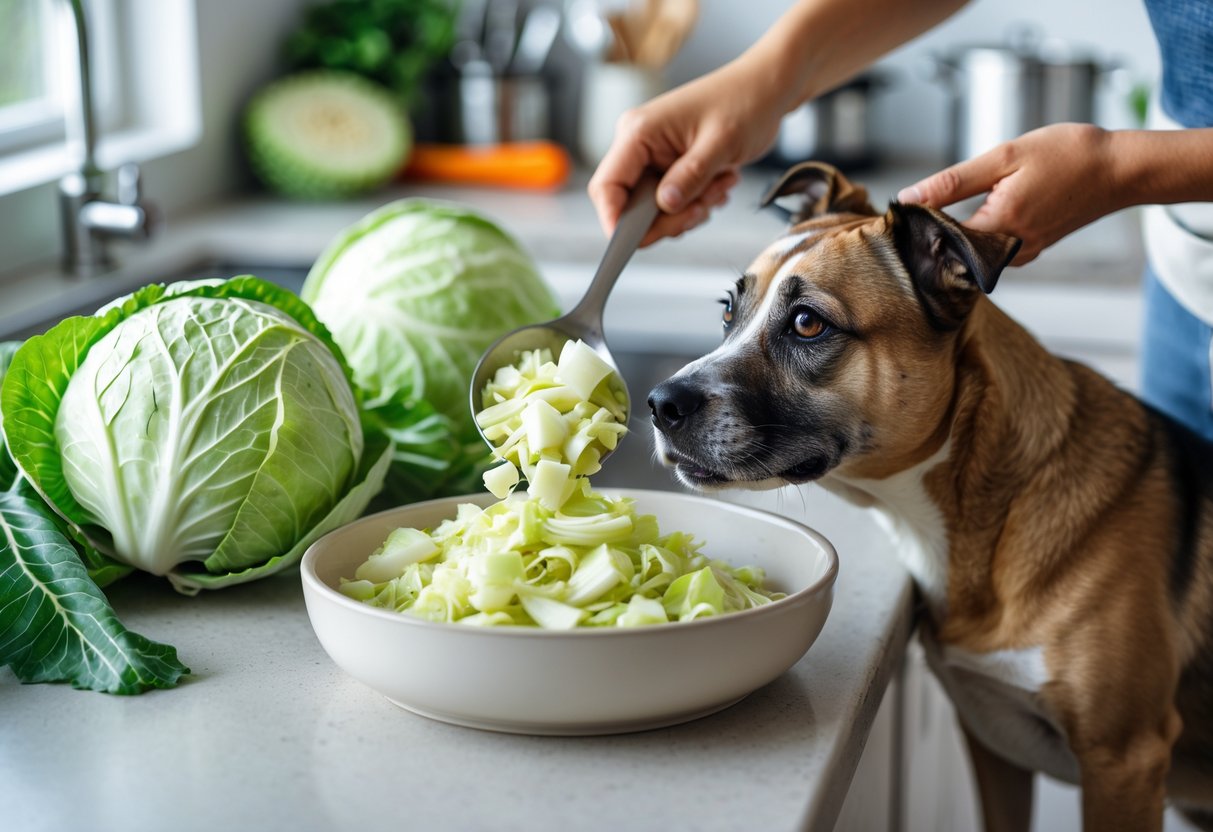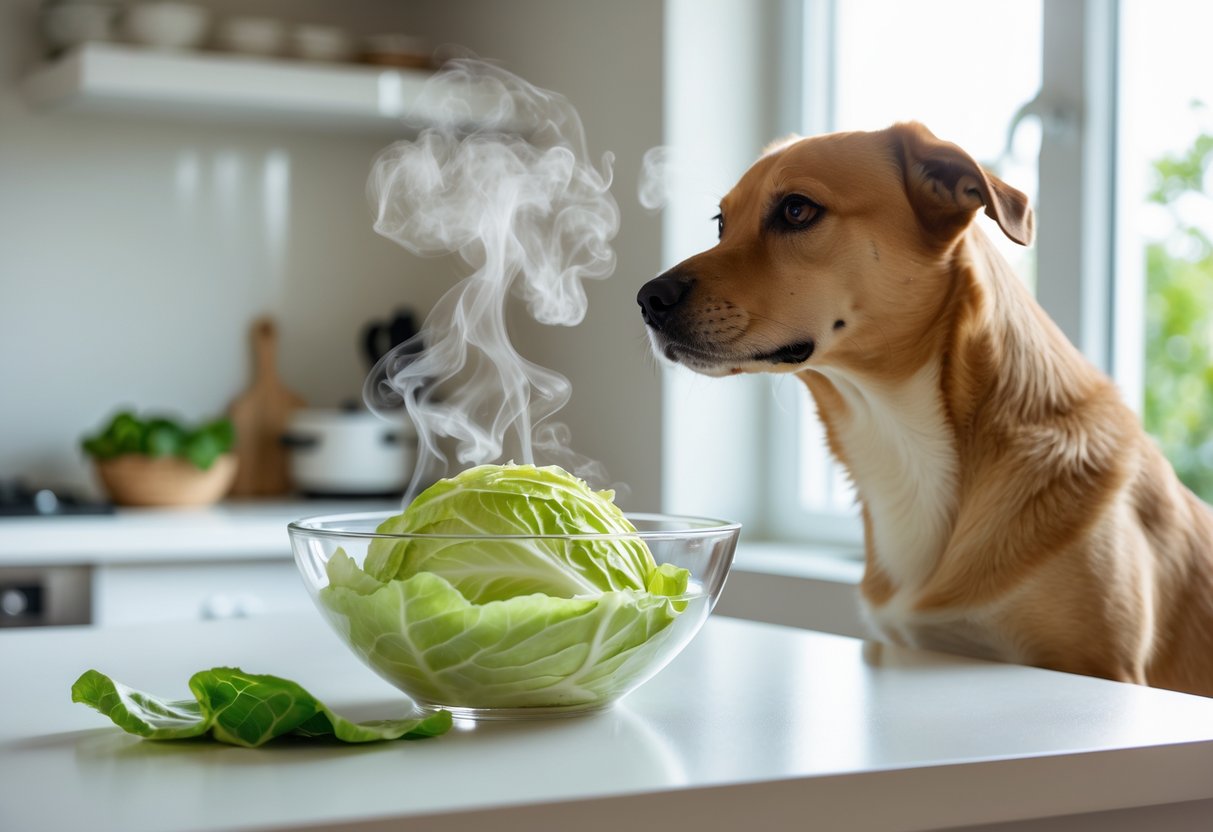If you’re wondering if you can safely share some cooked cabbage with your dog, the good news is that cooked cabbage is generally safe for dogs to eat in moderation. It can be a healthy treat that adds fibre and nutrients to their diet.
Just introduce it slowly to avoid any tummy troubles.
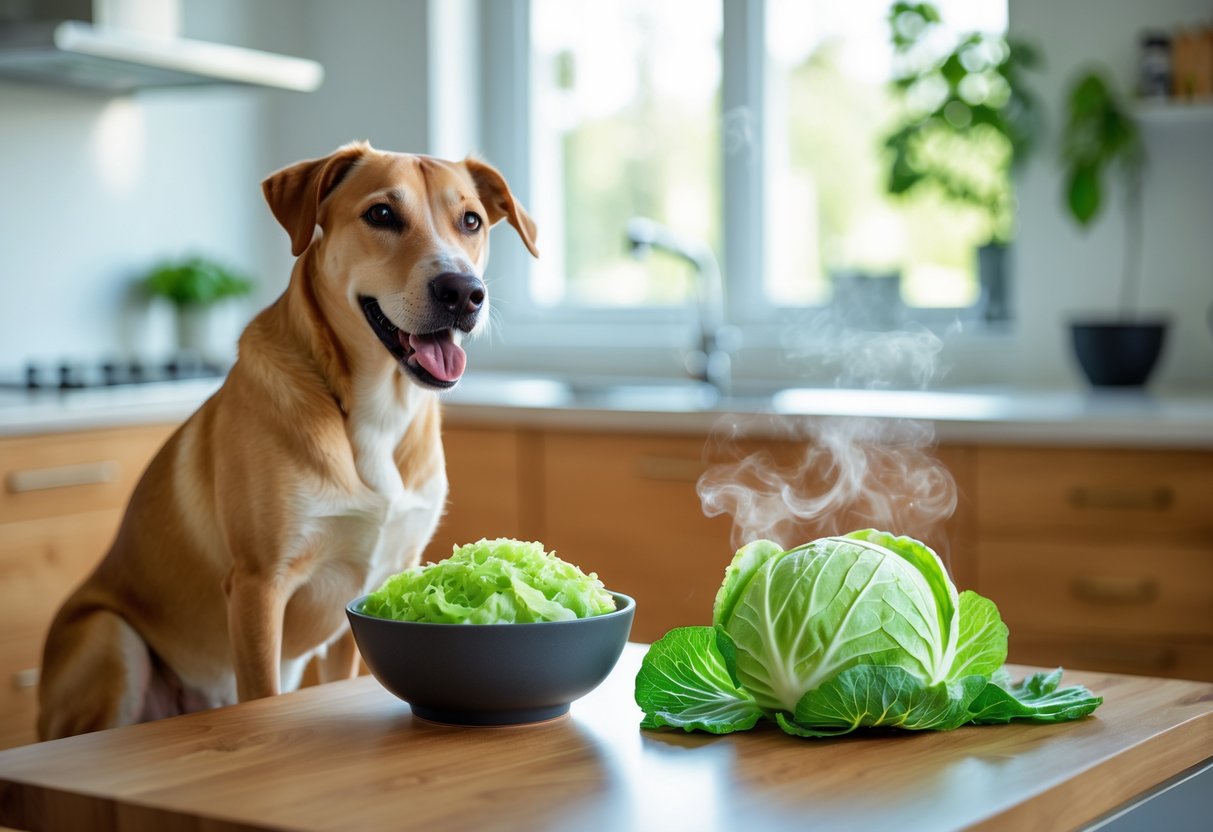
You might wonder how cooking affects cabbage and if it’s better than feeding it raw. You’ll also want to know the best way to prepare it so your dog gets the benefits without any risks.
Understanding these steps can help you make choices for your furry friend’s meals.
Key Takeaways
- Cooked cabbage can be a healthy treat for dogs when fed in small amounts.
- Proper preparation helps your dog digest cabbage more easily.
- Watch your dog’s reaction to cabbage and adjust servings accordingly.
Can Dogs Eat Cooked Cabbage?
You might be asking if cooked cabbage is a safe snack for your dog. It’s low in calories, has fibre, and carries important vitamins.
But you need to think about how you prepare it and how much you give to keep your dog happy and healthy.
Safety of Cooked Cabbage for Dogs
Cooked cabbage is safe for your dog, but only in small amounts. Some dogs have trouble digesting cabbage, which can cause gas, bloating, or diarrhoea if they eat too much.
Don’t add seasoning like onions, garlic, salt, or butter—these can be toxic to dogs. Steaming or boiling the cabbage until it’s soft makes it easier for your dog to digest.
Start slowly when adding new foods to your dog’s meals so you can watch for any signs of discomfort or allergic reactions. If your dog has a sensitive stomach, be extra careful.
Cooked Versus Raw Cabbage
While dogs can eat raw cabbage, many prefer cooked cabbage because it tastes less bitter. Cooking breaks down fibres, making it gentler on your dog’s tummy.
Raw cabbage can cause more digestive problems like gas or upset stomach. If you choose raw cabbage, wash it well and cut it into small pieces.
But honestly, steaming or boiling cabbage is usually the better choice for your dog’s digestion and enjoyment.
Recommended Serving Sizes
When feeding your dog cooked cabbage, moderation is key. Start with a small spoonful—about one or two teaspoons for small dogs, and a bit more for larger ones.
You can slowly increase the amount if your dog handles it well. Too much cabbage can lead to digestive issues, so think of it as a treat, not a main meal.
Mix small amounts into your dog’s regular food to add variety and nutrients. If your dog shows any sign of digestive distress, cut back or stop feeding cabbage and talk to your vet.
For more details, check the information on whether dogs can eat cooked cabbage safely.
Nutritional Value and Potential Benefits
When you offer your dog cooked cabbage, you’re giving more than just a treat. It comes packed with useful nutrients and brings some real benefits for your dog’s health.
Vitamins and Minerals in Cooked Cabbage
Cooked cabbage is a good source of vitamins like vitamin K and vitamin C. Vitamin K helps your dog’s blood clot and supports bone health.
Vitamin C acts as an antioxidant, protecting your dog’s cells from damage. Cabbage also contains minerals like calcium and potassium.
Calcium is important for strong bones and teeth. Potassium helps muscles and nerves work well.
Digestive Health and Fibre Benefits
Cooked cabbage provides fibre, which is essential for good digestion. It helps regulate your dog’s bowel movements.
Since cooked cabbage is easier to digest than raw, it tends to be gentler on your dog’s tummy. The fibre also supports healthy gut bacteria, which is important for digestion and overall health.
Weight Management Support
If you’re looking for a low-calorie treat to help your dog maintain or lose weight, cooked cabbage can be a good option. It’s naturally low in calories but filling because of the fibre and water content.
Feeding small amounts of cooked cabbage can satisfy your dog’s hunger without adding too many calories. Just serve it plain, without butter, salt, or seasonings like garlic or onion, so it stays safe and healthy. Learn more about cooked cabbage for dogs here.
Risks and Precautions to Keep in Mind
If you decide to feed cooked cabbage to your dog, it’s good to know what to watch for. Some issues might pop up if your dog eats too much or if their body reacts oddly.
Digestive Upset and Gas
Cooked cabbage can cause digestive problems in dogs, especially if given in large amounts. It contains fibre that your dog might not digest easily.
This can lead to gas, bloating, or even diarrhoea. Smaller dogs or dogs with sensitive stomachs are more likely to have these issues.
To avoid this, start with a tiny portion and see how your dog reacts. If they seem fine after a day, you can slowly increase the amount.
Watch for signs like farts, tummy rumbling, or loose stools. These are clues your dog might need less cabbage or a break from it.
Thyroid Concerns and Goitrogens
Raw cabbage contains goitrogens, which can interfere with your dog’s thyroid gland if eaten in large amounts. This might lead to hypothyroidism, causing tiredness and weight gain.
Cooking cabbage reduces these compounds, making it safer to feed your dog cooked cabbage. Still, don’t overfeed cabbage because even cooked cabbage has small amounts of goitrogens.
Feeding moderate amounts and mixing it with other healthy foods can protect your dog’s thyroid health. If your dog has a thyroid condition, check with your vet before adding cabbage.
Signs Your Dog Isn’t Tolerating Cabbage
You know your dog best, so keep an eye out for changes after eating cooked cabbage. Signs of intolerance include vomiting, diarrhoea, excessive gas, or a swollen belly.
Your dog might also show less energy or seem reluctant to eat. If you spot these symptoms, stop feeding cabbage and give your dog plain water.
Monitor their condition for a day or two. Persistent problems should be discussed with a vet.
For detailed information on feeding cabbage to dogs safely, visit American Kennel Club’s guide on dogs and cabbage.
How to Safely Prepare and Serve Cooked Cabbage
If you want to give your dog cooked cabbage, it’s important to prepare it the right way. Cooking methods, portion size, and how often you serve it all matter.
Choosing and Cooking Methods
Start with fresh, clean cabbage—white, red, or savoy all work. Avoid cabbage with brown spots or signs of spoilage.
Steam or boil the cabbage gently. Don’t fry it or cook it with oils, butter, onions, or garlic, as these are harmful or hard for your dog to digest.
Cut the cabbage into small, manageable pieces before cooking. This helps your dog chew and digest the cabbage more easily, and it prevents choking.
Cook for just a few minutes until the cabbage is tender but not mushy. Steaming keeps more vitamins intact than boiling.
Serving Guidelines and Frequency
Introduce cooked cabbage into your dog’s diet slowly. Start with a small amount, like a teaspoon to a tablespoon depending on their size.
Watch how your dog reacts, especially for signs of bloating or gas. Feed cooked cabbage only as a treat or a small addition to their main meals.
A good rule is to give no more than a tablespoon of cooked cabbage per day for medium to large dogs. For smaller dogs and puppies, cut this amount in half.
Mix the cooked cabbage with their normal food to keep meals interesting. Don’t make cabbage a major part of their diet—keep nutrition balanced.
When to Consult Your Vet
Check in with your vet if your dog shows any digestive distress like vomiting, diarrhoea, or excessive gas after eating cooked cabbage.
If your dog has health issues, especially thyroid problems or food sensitivities, talk to your vet before adding cabbage. Your vet can help with portion sizes based on your dog’s weight and health needs.
When starting any new food like cooked cabbage, keeping an eye on your dog and having your vet’s contact handy is always a good move.
For more tips on serving cabbage safely to your dog, you can find helpful info at petsradar.com on how dogs can eat cooked cabbage safely.
Frequently Asked Questions
Feeding your dog cooked cabbage has its perks, but you’ve got to be careful. How often should you offer it? What’s the best way to prepare it? There’s a bit to consider if you want to keep your dog healthy.
Is it safe to serve your dog cabbage on a daily basis?
Honestly, giving your dog cabbage every day isn’t a great idea. Too much can lead to gas or a little digestive trouble. Stick to small amounts now and then for a safer, more balanced approach.
What are the health benefits of feeding cabbage to your dog?
Cabbage doesn’t pack many calories, but it’s loaded with fibre. You’ll also find vitamins like K, C, and B6, plus important minerals. These nutrients can help your dog stay healthy and manage their weight.
How should cabbage be prepared to ensure it’s dog-friendly?
Cook the cabbage plain—skip the seasonings and fats. Steaming or boiling until it’s soft makes it easier for your dog to chew and swallow, which means less risk of choking.
Might some dogs experience digestive upset from eating cabbage?
Some dogs might get gassy, bloated, or just have an upset stomach after eating cabbage. Try a little bit at first, then see how your dog handles it. If things seem off, it’s probably best to stop.
Can serving cabbage alongside carrots be a healthy treat for your dog?
Mixing cabbage with carrots? That can be a fun, healthy snack. Both veggies are light on calories and bring their own vitamins and fibre, so your dog gets a bit of variety.
Are there any differences between purple and green cabbage for dogs?
Both purple and green cabbage are safe for dogs if you cook them first. Purple cabbage does have a bit more antioxidants, but honestly, they’re pretty similar when it comes to nutrition for dogs.
You can give your dog either type, just keep it in moderation. Want to dig deeper? Check out more about feeding cooked cabbage to dogs at Vet Explains Pets.


